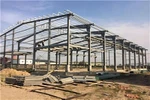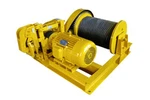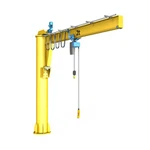Forged Wheels For Crane
Forged wheels for cranes are critical components designed to withstand heavy loads, high stress, and harsh operating conditions. They are commonly used in overhead cranes, gantry cranes, and other material handling equipment. Here's a detailed overview:
Key Features of Forged Crane Wheels:
Material & Strength:
Typically made from high-quality forged steel (e.g., AISI 1045, 4140, or alloy steels) for superior strength and durability.
Forging enhances grain structure, improving fatigue resistance and load capacity.
Heat Treatment:
Often hardened and tempered to achieve optimal hardness (e.g., 55-60 HRC for tread surfaces) while maintaining toughness.
Induction hardening or flame hardening may be applied to the wheel tread for wear resistance.
Precision Machining:
Ground or machined to tight tolerances for smooth operation and reduced rail wear.
Flanges may be included to prevent derailment.
Load Capacity:
Designed for dynamic and static loads ranging from a few tons to several hundred tons, depending on crane specifications.
Types of Forged Crane Wheels:
Double-Flanged Wheels: For guided travel on rails (common in overhead cranes).
Flat-Face Wheels: Used with external guide rails or in gantry systems.
Tapered Wheels: For curved track applications to prevent slippage.

5) The high quality wheel set is made of 45# steel die forging, roughing, conditioning and finishing. The hardness of heat treatment is HB305 ~ 385, and the hardness of hardening layer at 18mm depth is not less than HB250. The wheel shaft is made of 45# steel, which is roughed, tempered and finished. The hardness of heat treatment is 250 ~ 280HB.

Material:
Materials Used
Common materials for forged crane wheels include:
Carbon Steel (AISI 1045, 1055, 1065) – General-purpose wheels with good strength.
Alloy Steel (AISI 4140, 4340) – Higher strength and toughness for heavy-duty cranes.
Stainless Steel (SS 304, 316) – For corrosive environments (e.g., marine cranes).
Heat-Treated Steels – Quenched & tempered for enhanced hardness.
- Diameter: Φ250, Φ350, Φ400, Φ500, Φ600, Φ700, Φ800, Φ 1000, Φ 1200 or as your requirement
- Technique: Casting or forging
- Quenching Depth: more than 25mm
- Heat Treatment: Quenching and tempering
- Work environment temperature: -25℃~+40℃, relative humidity ≤85%
- Reference Price Range: $80-1000/piece
- Rated Loading Capacity: 1~1200 ton

Sketch

Advantages
Forged wheels for cranes offer several advantages over cast or fabricated wheels, making them a preferred choice for heavy-duty applications. Here are the key benefits:
1. Superior Strength & Durability
Forged wheels are made by compressing metal under high pressure, resulting in a denser, stronger grain structure compared to cast wheels.
They can withstand heavy loads, high impacts, and extreme working conditions without cracking or deforming.
2. Enhanced Fatigue Resistance
The forging process eliminates internal voids and porosity, reducing the risk of fatigue failure under repeated stress.
Ideal for cranes that operate continuously in demanding environments (e.g., ports, construction, steel mills).
3. Better Wear Resistance
Forged wheels typically have a harder surface, reducing wear from friction against rails or runways.
Longer service life means reduced downtime and maintenance costs.
4. Higher Load Capacity
Due to their superior material integrity, forged wheels can handle higher load capacities compared to cast wheels of the same size.
Essential for heavy-duty cranes, gantry systems, and overhead lifting equipment.
5. Improved Safety & Reliability
Less prone to defects (such as cracks or inclusions) compared to cast wheels.
Reduced risk of catastrophic failure, enhancing workplace safety.
6. Lighter Weight (Compared to Cast Wheels of Similar Strength)
Forging allows for optimized material distribution, reducing unnecessary weight while maintaining strength.
Helps improve crane efficiency and reduces energy consumption.
7. Better Dimensional Accuracy & Surface Finish
Forged wheels have tighter tolerances and smoother surfaces, ensuring better alignment and reduced rail wear.
8. Corrosion & Heat Resistance (Depending on Material)
Can be made from high-grade alloy steels or stainless steel for enhanced corrosion resistance in harsh environments (e.g., marine applications).
Application
Common Crane Applications:
Overhead Cranes – Forged wheels ensure smooth travel on runway beams.
Gantry Cranes – Heavy-duty forged wheels handle dynamic loads in shipyards and construction.
Port Cranes (RTG, STS) – High load capacity and corrosion resistance for harsh environments.
Steel Mill Cranes – Heat-resistant forged wheels withstand extreme temperatures.


Production Procedure
1. Material Selection and Preparation
Material choice: Typically high-grade alloy steels (e.g., 42CrMo, 65Mn, or similar high-strength alloys)
Quality control: Chemical composition verification through spectrometry
Billet preparation: Cutting raw material to required weights/sizes for forging
2. Heating Process
Pre-heating: Gradual heating to 600-800°C to prevent thermal shock
Final heating: Induction or furnace heating to forging temperature (1100-1250°C depending on alloy)
Temperature monitoring: Infrared pyrometers for precise temperature control

3. Forging Operation
Pre-forging: Rough shaping using hydraulic or mechanical presses
Die forging: Precision forming in closed dies under high pressure (typically 4000-10000 tons)
Flash removal: Trimming excess material while still hot
4. Heat Treatment
Normalizing: To refine grain structure and relieve internal stresses
Quenching: Rapid cooling in oil or polymer medium for hardness
Tempering: Reheating to 400-600°C to achieve optimal toughness/hardness balance

5. Machining Process
Rough machining: Turning outer diameters and basic profiles
Precision machining: CNC machining of bearing seats, flanges, and tread surfaces
Groove cutting: For rail guidance systems if required
Drilling/tapping: For mounting holes and assembly points
6. Quality Inspection
Dimensional checks: CMM (Coordinate Measuring Machine) verification
Hardness testing: Brinell or Rockwell hardness tests at multiple points
UT inspection: Ultrasonic testing for internal defects
MT/PT inspection: Magnetic particle or penetrant testing for surface defects

7. Surface Treatment
Shot blasting: For surface cleaning and stress relief
Coating: Application of protective coatings (zinc, paint, or specialized coatings)
Marking: Laser engraving of part numbers and specifications

8. Final Assembly (if applicable)
Bearing installation: Press fitting of tapered roller bearings
Sealing: Installation of labyrinth seals or other protective systems
Lubrication: Application of grease or other lubricants

9. Packaging and Shipping
Protective wrapping: VCI paper or other anti-corrosion measures
Custom crating: Wooden or steel crates for heavy wheels
Documentation: Including material certificates, inspection reports, and handling instructions

Workshop View
The company has installed an intelligent equipment management platform, and has installed 310 sets (sets) of handling and welding robots. After the completion of the plan, there will be more than 500 sets (sets), and the equipment networking rate will reach 95%. 32 welding lines have been put into use, 50 are planned to be installed, and the automation rate of the entire product line has reached





Hot Tags: forged wheels for crane, China forged wheels for crane manufacturers, suppliers, factory, Crane Parts, Forged Crane Wheels, Forged Train Wheels, Forged Wheel, Steel Rail Wheels, Wheels
Previous
No InformationYou Might Also Like
Send Inquiry

























